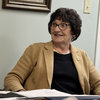New Scotland may soon have its first large-scale solar farm
NEW SCOTLAND — In July 2017, amid an influx of inquiries into large-scale solar development, New Scotland passed a local law governing solar energy with the primary goal of preserving farmland and open space.
Now, nearly 18 months after the law’s passage, technically, the first commercial solar field proposed under the new code may soon gain approval. (A solar farm off of Route 32 had been approved several years ago, but was never built).
“We are breaking new ground with this project literally,” said Charles Voss, the planning board’s chairman, at a Nov. 13 meeting.
In March, the United States Solar Corporation (US Solar) filed an application to build a 1.875-megawatt ground-mounted large-scale solar system at 331 New Scotland South Road. According to US Solar, 1.875 megawatts is enough energy to power about 350 homes for one year.
For the project, US Solar, which is based in Minnesota, will be leasing 18.5 acres between two parcels of land owned by Donald Baker and Martha Oden.
As a community solar farm, the electricity generated on site isn’t transmitted to individual customers; rather, it is sold to National Grid, which in turn credits customers who have signed on as members of the community farm.
In April, because of the way the law is written, Jeremy Cramer, New Scotland’s building inspector, had to deny US Solar’s application because there were prime soils located on the site where the solar system was to be installed.
According to the 2017 solar law, no large-scale projects are permitted on land that has prime soils, defined as “land that has the best combination of physical
and chemical characteristics for producing food, feed, forage, fiber, and oilseed crops and that is available for these uses,” or has more than an acre of mature forest, which contains trees that are predominantly six inches in diameter or more.
Since the solar law restricted building on prime soils, and in mature forest, the planning board needed an interpretation from the zoning board of appeals as to what is meant by “site” and “parcel,” with regard to soil conditions.
The zoning board determined that the location of the solar panels were not within the prime soils area of the lot, Cramer told The Enterprise. In addition, he said, US Solar put together information from soil surveys to show that the land was not capable of producing adequate farming.
Only the planning board has to approve the project, Cramer said, then US Solar would have to apply for a building permit from his office, for which he would conduct a review based on state code.
Public hearing
A Nov. 13 public hearing on the proposed solar farm acted like an informational question-and-answer session rather than a more typical contentious hearing that would accompany a large-scale construction project.
Residents came armed with specific questions about sound and lighting associated with the project; water runoff and stormwater management; and the screening of the solar panels from the street.
The most enthusiastic support for the project came from residents who would be most directly impacted by the new solar farm.
Voss said that the current configuration of the project aligns well with the solar code: there are extensive setback requirements not only from adjacent parcel lines but also from residential properties, which is an “inherent” part of the code; and there is extensive landscaping and screening that are required under the code.
“So, we are really trying to step methodically through the solar code, to make sure the project certainly fits for this site but also meets the intent of the code,” Voss said. “The applicants have certainly worked very diligently with us, very patiently certainly.”
During the public hearing, Lynne Furbeck, whose property is adjacent to the proposed solar farm, asked if there was any noise or nuisance lighting associated with the solar farm after it is installed, and was told by Voss that there would be none.
She then said there is a well on her property and she was concerned that the herbicides that would be used to control unwanted plants may contaminate her well. Jane Qualey, US Solar’s representative for the project, told Furbeck that the company has worked in densely-packed areas for a long time and has developed processes that takes into account neighbors with regard to weed control and spot spraying.
John Ragonese, who owns land across the street from the proposed project, asked how an area that is zoned for residential use is allowing a commercial use.
Cramer told him that, while the 2017 solar law has a number of restrictions, zoning is not one of them; a large-scale solar facility can be placed in almost any zone.
Cramer also said that the town code allows for commercial uses in a residential zones with a special-use permit or an approval from the planning or zoning boards.
“The fact that names are given to the zones that imply that they are anything else than what they are actually are right now, is kind of misleading,” Cramer said. “To say that it is a residential zone would be misleading; the fact is that there are commercial uses that are allowed with special approvals, such as a large-scale solar facility.”
Ragonese said that one day he hoped to build a home on his land and was concerned that he would be looking out onto hundreds of solar panels.
The solar code, Voss said earlier in the meeting, does not require 100-percent screening, it requires some softening and buffering and is an interpretation that planning board members will have to grapple with. However, screening had been an issue for the board and it had asked US Solar to come up with an enhanced landscape plan.
“The original layout was pretty barren,” Voss said. The second plan added more trees — and more mature trees over 7 feet tall — with a mix of deciduous and coniferous trees, with the intent to soften the landscape and create a more natural hedgerow. The new landscape plan now has 96 trees, which is nearly double what US Solar typically installs on its projects.
Chet Boehlke, also an adjacent property owner, said that the proposed solar farm probably affected him more than any other person in the room, because he lives across the street and looks directly onto the open field.
He said that the proposal is a great idea, that the town will receive taxes from the project and, unlike a housing development, there is no added traffic or increased student enrollment.
Voss said that the public-comment period would remain open until the planning board’s December meeting.
Subsidizing and taxing solar
New York State has overwhelmed the renewable-energy sector with subsidies, tax credits, and work.
In 2014, the state invested $1 billion in its NY-Sun initiative to expand solar capacity throughout New York. In September, Governor Andrew Cuomo announced that 84,000 solar installations had been supported by the New York State Energy Research and Development Authority, which manages the NY-Sun program.
In March, the governor announced $1.4 billion for 26 large-scale renewable energy projects, 22 of which are solar farms, and, in October, it was announced that the state would make available $40 million to support solar projects that integrate energy storage.
The state provides a 15-year real property-tax exemption for properties with either a wind or solar system. The law applies only to the benefit that the system adds to a property’s overall value; landowners with an installed wind or solar system are not exempt from all property taxes.
In 2017, statewide, there were 4,766 tax exemptions taken by properties with either a wind or solar system, according to the New York State Office of Real Property Tax Services; the total value of those exemptions was $795 million.
Also, in 2017, the state’s municipal governments and agencies, school districts, BOCES, and special districts took 74 property-tax exemptions valued at $19 million.
In Albany County, in 2017, twenty-six exemptions with a total value of $10.4 million were taken, according to the New York State Office of Real Property Tax Services.
However, the same solar law allows a local municipality to opt out of the exemption, which applies to both residential and commercial systems, and to collect property taxes on the solar systems, which New Scotland has done.
The town hasn’t yet seen any property-tax revenue from residential solar systems. Supervisor Douglas LaGrange told The Enterprise that the town’s assessor hasn’t considered residential systems a major change, and, so, hadn’t factored their benefit into a home’s assessed value.
“But when we’re talking a solar farm … A commercial money-making situation, we feel that’s a different animal,” LaGrange said, but New Scotland has yet to project the type of revenues it could receive from 331 New Scotland South Road, because the town’s assessor stepped down last month and her replacement has yet to start.
About 300 counties, towns, villages, and school districts in New York have opted out of the property-tax exemption for renewable energy systems.
A report from the Office of the New York State Comptroller notes that some municipalities have used the opt-out offer as a negotiating tactic to “encourage developers of large-scale energy providers to negotiate PILOTs (payments in lieu of taxes) or other concessions.”
In 2006, the Maple Ridge Wind Farm began operating; located in Lewis County, about 145 miles northwest of Albany County, the farm has 195 wind towers capable of generating 321 megawatts of electricity. It is the largest alternative-energy project east of the Mississippi River.
Lewis County as well as its municipalities and school districts receive millions of dollars in PILOT payments every year from Maple Ridge.
In 2016, for example, the Lowville Academy and Central School District, which opted out of the real property-tax exemption for renewable energy systems in 1990, received a $3.4 million PILOT payment from the Maple Ridge Wind Farm.
A 2015 state comptroller audit of the Lowville Academy and Central School District, found that, since 2006-07, in total, the district had received $32 million in PILOT payments from the wind farm.



